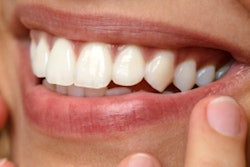
Midlines. There was a time you and I couldn't attend a clinical continuing education (CE) course, Google the word "smiles," or hop on social media without the standard Tom Cruise midline pics popping up. His smile donned the screen at every American Academy of Cosmetic Dentistry (AACD) turn.
But, clinically, what was it that made his midline jump out? Was it really because it was off horizontally -- or was there a more critical piece to that midline puzzle?
Take the young lady below as an example. Would you consider this is a great smile?
 All images courtesy of David Rice, DDS.
All images courtesy of David Rice, DDS.I think most of us would say we like it a lot. Smile follows the lower lip: check. A little bit of dominance on her centrals: check. Pretty good tooth-to-tissue ratios: check. But look closer. Is her midline in the middle of her face, or is it off by a good 1.5 mm? Did you notice that in the image?
I didn't either at first glance. It wasn't until I studied it and drew that second blue line that it became obvious to me.

Turns out, if you're anything like me, you're in the majority when it comes to the midline. In fact, the real take-home idea here is based on the amazing research of Vince Kokich Jr., DMD: A patient's midline can be up to 4 mm off horizontally before most dentists, orthodontists, and patients notice at all.
Yes, I said 4 mm! So, what was it that drove us all crazy with Tom Cruise's preorthodontic pics? It boils down to inherent nature. Where horizontal midline position is very forgiving, 2 mm is all it takes for us (and our patients) to see the problem.
Here's the caveat: insert day. If there is ever an occasion where our patients see any minor detail they never noticed before, when is it? You guessed it. It's insert day or debracket day.
There are two morals to this story. The seven deadly sins are all about diagnostic assessment, and as we assess midline and see that it is off on our patient, when is the best day to clue him or her in? The answer is day 1. That means once we have assessed incisal edge position, once we have looked at overall tooth position, and once we have determined the volume of teeth we need to incorporate to transition to the posterior segment well, then we need to assess the midline, both horizontally and vertically.
And we simply need to share where our patients are, along with what we'd need to do to get them to ideal. And if, in their eyes, after you've shared the statistics on how far off we can be horizontally, they'd like it spot on, midface, then you and I need to share what it's going to take to get there. And if they understand the horizontal, then we merely need to get vertical with our midlines.
Last and certainly not least, although I'm a big fan of same-day dentistry, I'm a bigger fan of test-driving anterior temporary restorations. I want my patient to live with his or her midline if it is off horizontally and we've only corrected their cant.
Friends, next time we dig deeper. Stay tuned!
The comments and observations expressed herein do not necessarily reflect the opinions of DrBicuspid.com, nor should they be construed as an endorsement or admonishment of any particular idea, vendor, or organization.


















